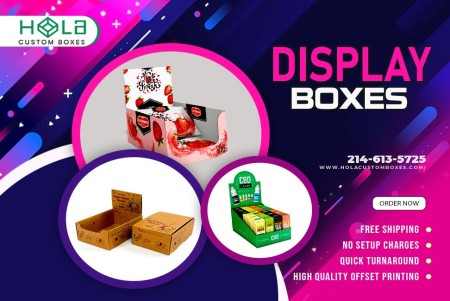The Various Types of Display Boxes
2025-11-29 17:16:41
Display Boxes: Versatile Packaging Solutions for Retail Success
Display boxes come in all shapes and sizes, and depending on the product you’re selling, you’ll need a different type of display box. These packaging solutions are designed not only to protect products but also to showcase them in a way that attracts attention and drives sales. At Hola Custom Boxes, we specialize in creating Custom Display Boxes that combine durability, functionality, and eye-catching design.
Common Types of Display Boxes
Slide-Together Boxes
Easy to assemble and compact, these boxes are perfect for small items that don’t require heavy protection. They’re ideal for temporary displays or setups that need to be moved frequently.
Die-Cut Mailer Boxes
Designed for shipping, die-cut mailer boxes protect products during transit and arrive ready to assemble. They’re a practical choice for e-commerce businesses.
Rigid Mailer Boxes
Offering more protection than die-cut mailers, rigid boxes are excellent for shipping fragile or premium products. While they can be more expensive, they add a layer of sophistication and security.
Folding Cartons
The most common type of display box, folding cartons are versatile and suitable for a wide range of products. They’re lightweight and cost-effective, though less durable than rigid options.
Explore our full range of Display Boxes to find the perfect solution for your business.
What Are Display Boxes?
Display boxes are specially designed packaging solutions used to showcase and organize products in retail environments. Typically made from cardboard or paperboard, they provide both protection and visibility.
Common uses include:
- Cosmetics and skincare products
- Snacks and confectionery
- Electronics and accessories
- Promotional merchandise
They can be custom-tailored to fit specific dimensions and branding needs, making them a powerful tool for retail presentation.
Benefits of Display Boxes
- Enhanced Visibility: Customers can view products without opening the package, which is especially important for perishables or cosmetics.
- Organization: Keeps products neatly arranged, streamlining inventory management.
- Sustainability: Most display boxes are made from recycled or recyclable materials.
- Protection: Sturdy structures safeguard delicate items like electronics or glassware.
- Cost Efficiency: Lightweight packaging reduces shipping costs while maintaining safety.
Boost Branding and Shelf Presence with Custom Display Boxes
.jpg)
A well-designed display box doesn’t just protect your product—it markets it. Custom printing, bold colors, and unique die-cut shapes make products stand out on crowded shelves.
Whether you’re launching a new product or running a seasonal campaign, display boxes act as miniature billboards that capture consumer attention at the point of sale. By combining functionality with strategic design, they become a powerful tool for both sales and branding.
Types of Display Packaging Materials
Cardboard Boxes
Lightweight, strong, and versatile, cardboard is the most common material for display packaging. It’s inexpensive, easy to print on, and eco-friendly.
Wooden Boxes
Wooden packaging adds a touch of luxury and durability. While heavier and more expensive, they’re reusable and ideal for premium products.
What Are Display Packaging Boxes Used For?
Display packaging is used to showcase products in retail settings such as:
- Countertop displays
- Floor displays
- Window displays
They can be made from cardboard, corrugated paperboard, or other materials depending on the product and brand requirements.
Die-Cutting Explained
Die-cutting is one of the most popular customization methods for display packaging. A sharp steel blade is used to cut shapes into materials, creating unique and eye-catching designs.
Common die-cut shapes include:
- Ovals
- Circles
- Squares
- Rectangles
- Triangles
- Stars
Die-cutting can also create cutouts that allow customers to see the product inside without opening the packaging.
Finishing Touches
Once your display packaging has been die-cut, finishing techniques add the final polish:
- Foil Stamping: Adds metallic shine for luxury appeal.
- Embossing/Debossing: Creates texture and depth.
- Glossy or Matte Lamination: Enhances durability and aesthetics.
- Spot UV: Highlights specific design elements with a sleek finish.
These embellishments give your packaging a professional look that grabs attention on store shelves.
Why Choose Hola Custom Boxes for Display Packaging?
At Hola Custom Boxes, we combine creativity, craftsmanship, and sustainability to deliver packaging that makes your brand shine.
- Customization Options: Die-cutting, foil stamping, embossing, and more.
- Eco-Friendly Solutions: Recyclable cardboard and kraft materials.
- Premium Quality: Durable packaging that protects and impresses.
- Customer-Centric Approach: Designs tailored to your brand’s unique needs.
Visit our homepage to learn more about our services and request a quote today.
Conclusion
Display boxes are more than packaging—they’re a marketing tool that enhances visibility, protects products, and builds brand recognition. From slide-together boxes to rigid mailers, the right choice depends on your product and business goals.
By investing in Custom Display Boxes, you create packaging that not only organizes and protects but also promotes your brand. Explore our Display Boxes today and discover how Hola Custom Boxes can help your products stand out in the competitive marketplace.
